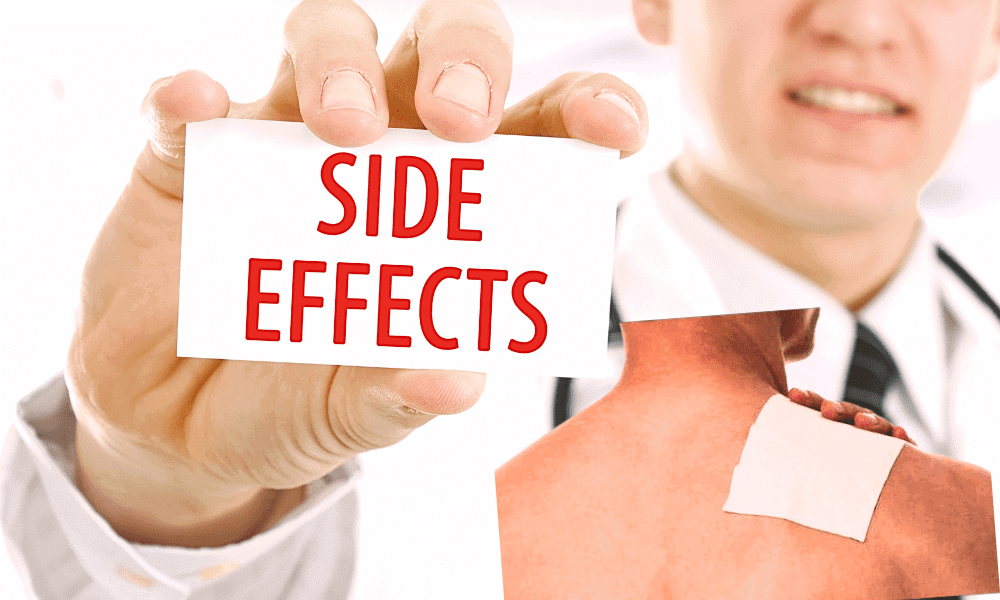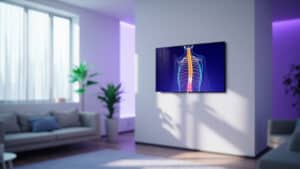Lidocaine patches are a popular choice for managing localized pain and discomfort. While these patches can be effective in providing relief, it’s important to be aware of potential side effects that may arise from their use. In this comprehensive guide, we’ll delve into the various side effects and offer insights on how to mitigate them effectively.
Lidocaine patches have gained popularity for their ability to provide localized relief from pain by means of targeted local anesthetics, whether the pain is caused by arthritis, muscle strains, or other conditions. However, as with any medication or treatment, there are potential side effects that individuals should be aware of.
Understanding the potential side effects can help users make informed decisions about their pain management strategies. By learning how to recognize and mitigate these side effects, users can maximize the benefits while minimizing any potential risks.

What Are Lidocaine Patches?
Lidocaine patches (also know as the Lidoderm patch)are medicated patches that contain the local anesthetic lidocaine. These patches are designed to adhere to the skin, allowing the local anesthetic medication to slowly and continuously seep through the skin and into the underlying tissues. Lidocaine works by numbing the nerves in the affected area, thereby reducing pain signals.
The patches are typically applied directly to the area experiencing pain or discomfort, such as the back, shoulder, or knee. They are available both over the counter and with a prescription, depending on the strength of the lidocaine concentration.
Lidocaine Patch Side Effects: An Overview
The Lidocaine 5% prescription patch, which is often utilized for conditions such as postherpetic neuralgia and other localized neuropathic pain disorders, works by numbing a specific area of the body to block pain signals from reaching the brain.
The Lidocaine 5% patch and Lidoderm patches are essentially the same thing, with Lidoderm being a specific brand name. Despite their impressive efficacy in managing localized pain, these patches, like all medications, carry the potential for side effects that patients should be aware of before use.
While generally well-tolerated, they may cause certain side effects that can be categorized into:
- localized skin reactions
- and systemic effects that affect the whole body.
Localized Skin Reactions
One of the most commonly reported side effects involves localized skin reactions. These reactions are generally mild and may include:
1. Skin Irritation:
A commonly reported side effect of the lidocaine patch and its local anesthetic is skin irritation. This can manifest as mild redness, itching, or discomfort at the site where the patch is applied. Such skin reactions can be a result of the body’s response to the adhesive used in the patch or the lidocaine itself. It’s crucial to note that these symptoms are usually temporary and resolve once the patch is removed. However, in some cases, the irritation might linger a bit longer, especially for those with sensitive skin.
As a protective measure, rotating the patch application site can help reduce skin irritation. Moreover, applying a skin moisturizer to the area, once the patch is removed and the skin is clean, can assist in soothing irritated skin. If skin irritation persists or intensifies, it’s recommended to seek medical advice promptly as it might be an indication of a more severe skin response. The medical professional may advise a different pain management strategy or an alternative to lidocaine, ensuring the patient’s comfort and safety.
2. Burning or Stinging Sensations:
Though generally safe and well-tolerated, lidocaine patches can cause an uncomfortable burning sensation or a stinging sensation for a minor subset of users. This sensation typically begins immediately upon applying the patch, often felt as a mild, tingling discomfort. It is crucial to remember that while some level of initial discomfort may be expected, this should lessen over time as the body acclimates to the medication.
However, if you find that a burning sensation occurs, or the stinging becomes severe, escalates, or persists without subsiding, it’s highly recommended to remove the patch promptly. These symptoms could potentially be an indication of a hypersensitivity to the local anesthetic medication. Consulting a healthcare professional in such instances is crucial to reassess the pain management strategy and possibly switch to an alternative method or different medication. The safety and comfort of patients always remain paramount, and no form of treatment should cause excessive or prolonged distress.
3. Skin Rash or Blistering:
While patches are generally safe to use, a few exceptional cases may experience more serious side effects, such as skin rash or blistering at the application site. This is not a common occurrence, but it can happen and it’s essential to be prepared and informed about how to respond to these symptoms.
If you notice a rash, blisters, or any abnormal skin changes where the patch was applied, you should discontinue the use of the patch immediately. This could potentially signal adverse effects or a more severe skin response. Such symptoms require immediate medical attention to mitigate any potential damage and to adjust your pain management approach.
Systemic Side Effects
While less common, some individuals may experience systemic adverse effects, these more serious side effects. These effects can include:
1. Dizziness or Lightheadedness:
Lidocaine can sometimes cause a temporary drop in blood pressure, leading to feelings of dizziness or lightheadedness. If these symptoms occur, it is recommended to sit or lie down until they subside.
2. Nausea or Vomiting:
Some individuals may experience mild gastrointestinal disturbances, such as nausea or vomiting. Staying hydrated and avoiding large meals before applying the patch can help minimize these effects.
3. Headache:
In rare cases, a lidocaine patch may trigger headaches. If headaches persist or worsen, it is advisable to consult a healthcare professional.
4. Allergic Reactions:
Although rare, some individuals may be allergic to lidocaine, local anesthetics, or other components of the patch. These reactions can manifest as hives, swelling, difficulty breathing, or chest tightness. If any signs of serious adverse effects occur, immediate medical attention should be sought.
5. Difficulty Breathing:
Experiencing difficulty in breathing after using a lidocaine patch is rare but serious, usually indicating a severe allergic reaction. If you encounter shortness of breath or chest tightness, seek immediate medical attention. Remember, it’s crucial to disclose any known allergies to your healthcare provider before starting any new treatment.
6. Changes in Blood Pressure:
Rarely, lidocaine patches may cause changes in blood pressure, leading to symptoms like dizziness or fainting. If these symptoms persist, get medical help promptly. It’s especially important to discuss your health history, including any cardiovascular conditions or related medications, with your healthcare provider before using these patches.
Now that we have explored the potential serious side effects, let’s address some frequently asked questions.

Frequently Asked Questions (FAQs)
- Are lidocaine patches safe?
They are generally safe when used as directed. However, it’s important to follow the instructions provided and consult a healthcare professional if you have any underlying medical conditions or concerns.
- Can lidocaine patches cause allergic reactions?
While rare, some individuals may experience allergic reactions to lidocaine or other components of the patch. If you notice signs of an allergic reaction, such as hives or difficulty breathing, seek immediate medical attention.
- How long do lidocaine patch adverse events last?
Most side effects are temporary and should subside after patch removal. However, if you experience persistent or severe side effects, it is advisable to consult a healthcare professional.
- Can lidocaine patches interact with other medications?
The patch may interact with certain medications, especially those that affect the heart or the central nervous system. It is crucial to inform your healthcare provider about all medications you are taking to avoid potential interactions.
- Are lidocaine patches safe during pregnancy?
Pregnant or breast feeding individuals should consult their healthcare provider before use. While there is limited data on the safety during pregnancy, it is essential to weigh the potential risks and benefits under medical guidance.
- How often should lidocaine patches be applied?
The frequency of application depends on the individual’s condition and the specific product. Always follow the instructions provided with the patch or consult a healthcare professional for guidance.
Minimizing Side Effects
To minimize the risk of experiencing other adverse events, consider the following guidelines:
- Patch Placement and Duration
- Apply the patch only to intact, clean, and dry skin.
- Avoid placing the patch on areas with irritated broken skin.
- Limit patch use to the recommended duration, typically up to 12 hours within a 24-hour period.
- Skin Sensitivity Testing
- Before using a lidocaine patch for the first time, perform a skin sensitivity test to test for any reaction to the local anesthetics.
- Apply a small portion of the patch to a small area of skin and monitor for any adverse reactions for at least 24 hours.
- Proper Patch Removal
- To remove the patch, gently peel it off without pulling or stretching the skin.
- Dispose of used patches properly to prevent accidental exposure to children or pets.
- By adhering to these guidelines, users can enhance the effectiveness while minimizing the risk of side effects.
Conclusion
Lidocaine patches can be a valuable tool in managing localized pain and discomfort. While they are generally safe, it’s important to be aware of potential side effects. By understanding the various common side effects and following recommended guidelines, users can use these patches safely and effectively.
Remember, if you experience severe or persistent common side effects, it’s crucial to consult a healthcare professional for further guidance. Pain management should always be personalized and monitored to ensure the best possible outcome.
Performance Pain and Sports Medicine has prescription pain patches available via telemedicine (so go check out our store now), or you can see Dr. Suzanne Manzi in person at the Houston or League City locations in Texas. Dr. Matthias Wiederholz is available for in person visits in Houston, TX and Lawrenceville, NJ. Contact us now to learn more.
this post was edited and updated on 7/13/2023

















